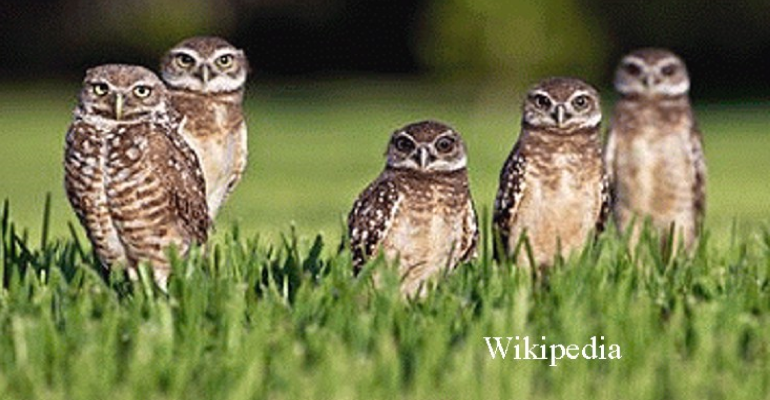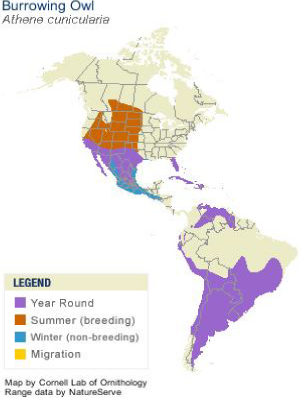
Burrowing owls (Athene cunicularia) range from western Canada, through the western United States and southward all the way to the tip of South America at Tierra del Fuego. A separate subspecies is found in Florida and the Caribbean Islands. These owls prefer open land, deserts, prairies and grasslands. They often occur at the edges of disturbed agricultural land, housing developments, and golf courses.
 The Arizona-Sonora Desert Museum has recently acquired two young burrowing owls which will soon be made available to Docents to handle and interpret.
The Arizona-Sonora Desert Museum has recently acquired two young burrowing owls which will soon be made available to Docents to handle and interpret.
Burrowing owls are relatively small, with a body length of 7 to 10 inches and a wingspan of about 22 inches. Unlike other raptors where the female is larger than the male, burrowing owl adult males and females are about the same size. They have long legs and short tails.
True to their name, burrowing owls live underground. They may dig their own burrows in soft soil, but more often appropriate holes dug by other animals such as squirrels, prairie dogs, or skunks.
They feed during both the day and night and are most active in early morning and at dusk. They feed on insects, rodents and small reptiles. According to the Cornell Lab of Ornithology, “The Burrowing Owl collects mammal dung and puts it in and around its burrow. The dung attracts dung beetles, which the owl then captures and eats.” It seems they are ranchers.
The female lays five to ten white eggs in the burrow which hatch in about four weeks. The chicks stay in the burrow for about 40 days until they are ready to fledge. For protection, the chicks can make a noise very similar to a rattlesnake. Listen to the various calls from Cornell here. The one that sounds like a rattlesnake is the “Juvenile alarm call” at the bottom of the list. See 5 minute video: https://www.youtube.com/watch?v=3gdU6FHSlXk
Burrowing owls are social and may live in colonies. See more images here.
Related articles:
Note to readers: I have constructed a linked index to more than 300 of my ADI articles. You can see it at: https://wryheat.wordpress.com/adi-index/
You can read my comprehensive, 28-page essay on climate change here: http://wp.me/P3SUNp-1bq
